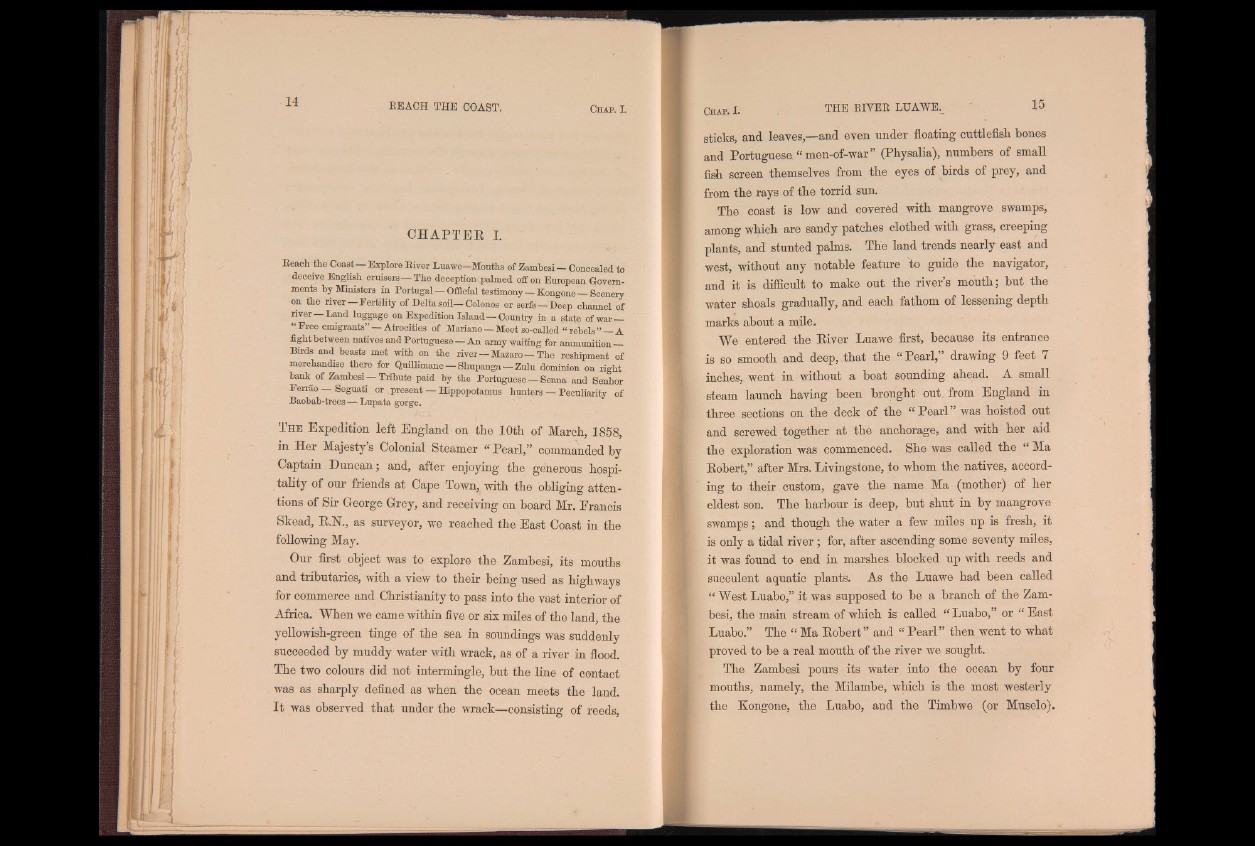
C H A P T E R I.
Reach the Coast — Explore River Luawe—Mouths of Zambesi — Concealed to
deceive English cruisers—The deception palmed off on European Governments
by Ministers in Portugal — Official testimony — Eongone Scenery
on the river Fertility of Delta soil— Colonos or serfs — Deep channel of
river—Land luggage on Expedition Island — Country in a state of war—
“ Free emigrants” —Atrocities of Mariano —Meet so-called “ rebels” —A
fight between natives and Portuguese—An army waiting for ammunition —
Birds and beasts met with on the river—Mazaro —The reshipment of
merchandise there for Quillimane — Shupanga—Zulu dominion on right
bank of Zambesi—Tribute paid by the Portuguese — Senna and Senhor
Ferrao Seguati or present — Hippopotamus hunters — Peculiarity of
Baobab-trees —- Lupata gorge.
T h e Expedition left England on the 10th of March, 1858,
in Her Majesty s Colonial Steamer “ Pearl,” commanded by
Captain Duncan; and, after enjoying the generous hospitality
of our friends at Cape Town, with the obliging attentions
of Sir George Grey, and receiving on board Mr. Francis
Skead, R.N., as surveyor, we reached the East Coast in the
following May.
Our first object was to explore the Zambesi, its mouths
and tributaries, with a view to their being used as highways
for commerce and Christianity to pass into the vast interior of
Africa. When we came within five or six miles of the land, the
yellowish-green tinge of the sea in soundings was suddenly
succeeded by muddy water with wrack, as of a river in flood.
The two colours did not intermingle, but the line of contact
was as sharply defined as when the ocean meets the land
I t was observed that under the wrack—consisting of reeds,
sticks, and leaves,—and even under floating cuttlefish bones
and Portuguese “ men-of-war” (Physalia), numbers of small
fish screen themselves from the eyes of birds of prey, and
from the rays of the torrid sun.
The coast is low and covered with mangrove swamps,
among which are sandy patches clothed with grass, creeping
plants, and stunted palms. The land trends nearly east and
west, without any notable feature to guide the navigator,
and it is difficult, to make out the river’s mouth; but the
water shoals gradually, and each fathom of lessening depth
marks about a mile.
We entered the River Luawe first, because its entrance
is so smooth and deep,.that the “ Pearl,” drawing 9 feet 7
inches, went in without a boat sounding ahead. A small
steam launch having been brought out. from England in
three sections on the deck of the “ Pearl” was hoisted out
and screwed together at the anchorage, and with her aid
the exploration was commenced. She was called the “ Ma
Robert,” after Mrs. Livingstone, to whom the natives, according
to their custom, gave the name Ma (mother) of her
eldest son. The harbour is deep, but shut in by mangrove
swamps; and though the water a few miles up is fresh, it
is only a tidal river; for, after ascending some seventy miles,
it was found to end in marshes blocked up with reeds and
succulent aquatic plants. As the Luawe had been called
“ West Luabo,” it was supposed to be a branch of the Zambesi,
the main stream of which is called “ Luabo,” or “ East
Luabo.” The “ Ma Robert” and “ Pearl” then went to what
proved to be a real mouth of the river we sought.
The Zambesi pours its water into the ocean by four
mouths, namely, the Milambe, which is the most westerly
the Kongone, the Luabo, and the Timbwe (or Muselo).